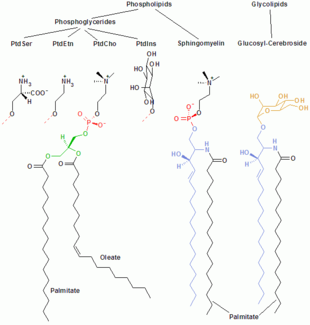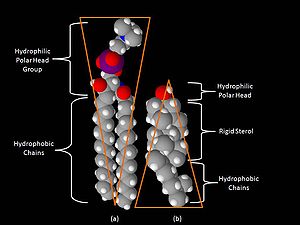
Membrane lipids
Encyclopedia

Phospholipid
Phospholipids are a class of lipids that are a major component of all cell membranes as they can form lipid bilayers. Most phospholipids contain a diglyceride, a phosphate group, and a simple organic molecule such as choline; one exception to this rule is sphingomyelin, which is derived from...
s, glycolipid
Glycolipid
Glycolipids are lipids with a carbohydrate attached. Their role is to provide energy and also serve as markers for cellular recognition.-Metabolism:...
s, and cholesterol
Cholesterol
Cholesterol is a complex isoprenoid. Specifically, it is a waxy steroid of fat that is produced in the liver or intestines. It is used to produce hormones and cell membranes and is transported in the blood plasma of all mammals. It is an essential structural component of mammalian cell membranes...
.
Phospholipids
Phospholipids and glycolipids consist of two long, nonpolar (hydrophobic) hydrocarbon chains linked to a hydrophilic head group.The heads of phospholipids are phosphorylated and they consist of either:
- Glycerol (and hence the name phosphoglycerides given to this group of lipids).
- Sphingosine (with only one member - sphingomyelinSphingomyelinSphingomyelin is a type of sphingolipid found in animal cell membranes, especially in the membranous myelin sheath that surrounds some nerve cell axons. It usually consists of phosphorylcholine and ceramide...
).
Glycolipids
The heads of glycolipids contain a sphingosineSphingosine
Sphingosine is an 18-carbon amino alcohol with an unsaturated hydrocarbon chain, which forms a primary part of sphingolipids, a class of cell membrane lipids that include sphingomyelin, an important phospholipid.-Functions:...
with one or several sugar units attached to it. The hydrophobic chains belong either to:
- two fatty acidFatty acidIn chemistry, especially biochemistry, a fatty acid is a carboxylic acid with a long unbranched aliphatic tail , which is either saturated or unsaturated. Most naturally occurring fatty acids have a chain of an even number of carbon atoms, from 4 to 28. Fatty acids are usually derived from...
s - in the case of the phosphoglycerides. - one FA and the hydrocarbon tail of sphingosineSphingosineSphingosine is an 18-carbon amino alcohol with an unsaturated hydrocarbon chain, which forms a primary part of sphingolipids, a class of cell membrane lipids that include sphingomyelin, an important phospholipid.-Functions:...
- in the case of sphingomyelin and the glycolipids.
Fatty acids
The fatty acidFatty acid
In chemistry, especially biochemistry, a fatty acid is a carboxylic acid with a long unbranched aliphatic tail , which is either saturated or unsaturated. Most naturally occurring fatty acids have a chain of an even number of carbon atoms, from 4 to 28. Fatty acids are usually derived from...
s in phospho- and glycolipids usually contain an even number of carbon
Carbon
Carbon is the chemical element with symbol C and atomic number 6. As a member of group 14 on the periodic table, it is nonmetallic and tetravalent—making four electrons available to form covalent chemical bonds...
atoms, typically between 14 and 24. The 16- and 18-carbon FAs are the most common ones. FAs may be saturated or unsaturated, with the configuration of the double bond
Double bond
A double bond in chemistry is a chemical bond between two chemical elements involving four bonding electrons instead of the usual two. The most common double bond, that between two carbon atoms, can be found in alkenes. Many types of double bonds between two different elements exist, for example in...
s nearly always cis. The length and the degree of unsaturation
Saturation (chemistry)
In chemistry, saturation has six different meanings, all based on reaching a maximum capacity...
of FAs chains have a profound effect on membranes' fluidity
Fluidity
Fluidity may refer toIn science*reciprocal of viscosity*Cognitive fluidity*Membrane fluidity*Sexual fluidityOthers*Fluidity *Dark Fluidity – a literature magazine*Empire Fane ship...
.
Phosphoglycerides
In phosphoglycerides, the hydroxyl groups at C-1 and C-2 of glycerol are esterified to the carboxyl groups of the FAs. The C-3 hydroxyl group is esterified to phosphoric acid. The resulting compound, called phosphatidatePhosphatidate
Phosphatidic acids are the acid forms of phosphatidates, a part of common phospholipids, major constituents of cell membranes. Phosphatidic acids are the simplest diacyl-glycerophospholipids.-Structure:...
, is the simplest phosphoglycerate
Phosphoglycerate
Phosphoglycerate may refer to:* 2-Phosphoglycerate* 3-Phosphoglycerate...
. Only small amounts of phosphatidate are present in membranes. However, it is a key intermediate in the biosynthesis
Biosynthesis
Biosynthesis is an enzyme-catalyzed process in cells of living organisms by which substrates are converted to more complex products. The biosynthesis process often consists of several enzymatic steps in which the product of one step is used as substrate in the following step...
of the other phosphoglycerides.
Sphingosine
Sphingosine is an amino alcoholAmino alcohol
Amino alcohols are organic compounds that contain both an amine functional group and an alcohol functional group.-Common amino alcohols:* Ethanolamines* Heptaminol* Isoetarine* Norepinephrine* Propanolamines* Sphingosine...
that contains a long, unsaturated
Saturation (chemistry)
In chemistry, saturation has six different meanings, all based on reaching a maximum capacity...
hydrocarbon chain. In sphingomyelin and glycolipids, the amino group of sphingosine is linked to FAs by an amide
Amide
In chemistry, an amide is an organic compound that contains the functional group consisting of a carbonyl group linked to a nitrogen atom . The term refers both to a class of compounds and a functional group within those compounds. The term amide also refers to deprotonated form of ammonia or an...
bond. In sphingomyelin the primary hydroxyl
Hydroxyl
A hydroxyl is a chemical group containing an oxygen atom covalently bonded with a hydrogen atom. In inorganic chemistry, the hydroxyl group is known as the hydroxide ion, and scientists and reference works generally use these different terms though they refer to the same chemical structure in...
group of sphingosine is esterified to phosphoryl choline
Choline
Choline is a water-soluble essential nutrient. It is usually grouped within the B-complex vitamins. Choline generally refers to the various quaternary ammonium salts containing the N,N,N-trimethylethanolammonium cation....
. In glycolipids, the sugar component is attached to this group. The simplest glycolipid is cerebroside
Cerebroside
Cerebrosides is the common name for a group of glycosphingolipids called monoglycosylceramides which are important components in animal muscle and nerve cell membranes.They consist of a ceramide with a single sugar residue at the 1-hydroxyl moiety...
, in which there is only one sugar residue, either Glc
Glucose
Glucose is a simple sugar and an important carbohydrate in biology. Cells use it as the primary source of energy and a metabolic intermediate...
or Gal
Galactose
Galactose , sometimes abbreviated Gal, is a type of sugar that is less sweet than glucose. It is a C-4 epimer of glucose....
. More complex glycolipids, such as ganglioside
Ganglioside
Ganglioside is a molecule composed of a glycosphingolipid with one or more sialic acids linked on the sugar chain. The 60+ known gangliosides differ mainly in the position and number of NANA residues.It is a component of the cell plasma membrane that modulates cell signal transduction events...
s, contain a branched chain of as many as seven sugar residues.
Cholesterol

Cholesterol
Cholesterol is a complex isoprenoid. Specifically, it is a waxy steroid of fat that is produced in the liver or intestines. It is used to produce hormones and cell membranes and is transported in the blood plasma of all mammals. It is an essential structural component of mammalian cell membranes...
occurs naturally in eukaryote
Eukaryote
A eukaryote is an organism whose cells contain complex structures enclosed within membranes. Eukaryotes may more formally be referred to as the taxon Eukarya or Eukaryota. The defining membrane-bound structure that sets eukaryotic cells apart from prokaryotic cells is the nucleus, or nuclear...
cell membranes where it is bio-synthesised from mevalonate via a squalene cyclisation of terpenoids. It associated preferentially with sphingolipids (see diagram) in cholesterol-rich lipid rafts areas of the membranes in eukaryotic cells. Hopanoids
Hopanoids
Hopanoids are natural pentacyclic compounds based on the chemical structure of hopane. Their primary function is to improve plasma membrane strength and rigidity in bacteria. In eukaryotes cholesterol serves a similar function...
serve a similar function in prokaryotes.
Cell membranes require high levels - typically an average of 20% cholesterol molecular in the whole membrane, increasing locally in raft areas up to 50% cholesterol (- % is molecular ratio) Formation of lipid rafts promotes aggregation of peripheral and transmembrane proteins including docking of SNARE
Snare
Snare may refer to:* Snare trap, a kind of trap used for capturing animals* Snare drum* SNARE , a family of proteins involved in vesicle fusion* The Snares, a group of islands approximately 200 kilometres south of New Zealand...
and VAMP
VAMP
Vesicle associated membrane proteins are a family of SNARE proteins with similar structure, and are mostly involved in vesicle fusion.* VAMP1 and VAMP2 proteins known as synaptobrevins are expressed in brain and are constituents of the synaptic vesicles, where they participate in neuromediator...
proteins

